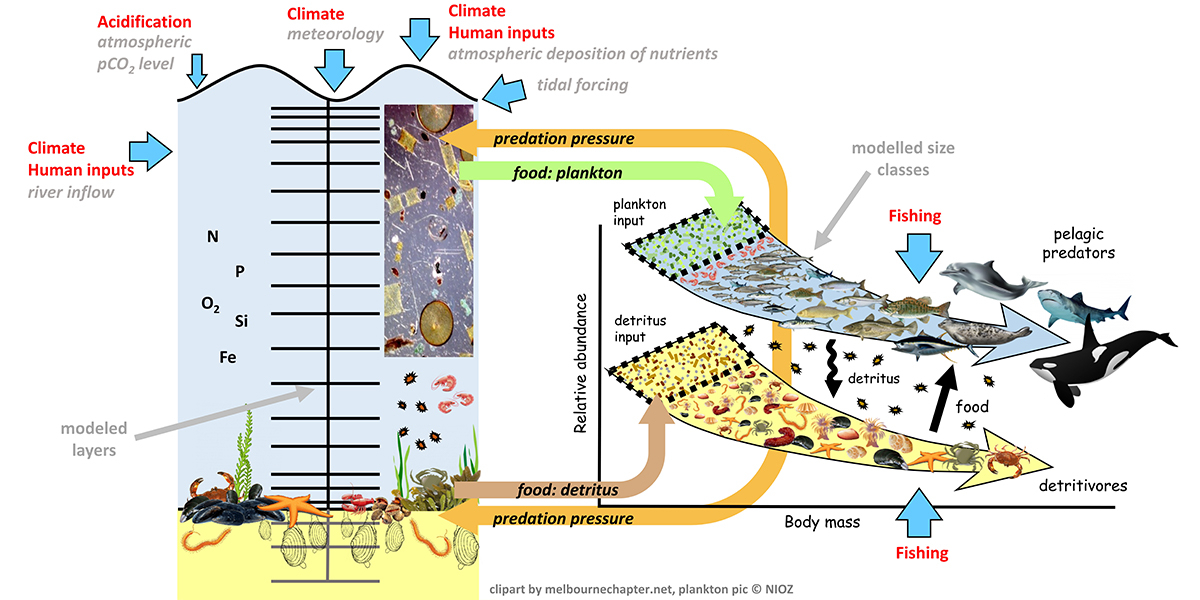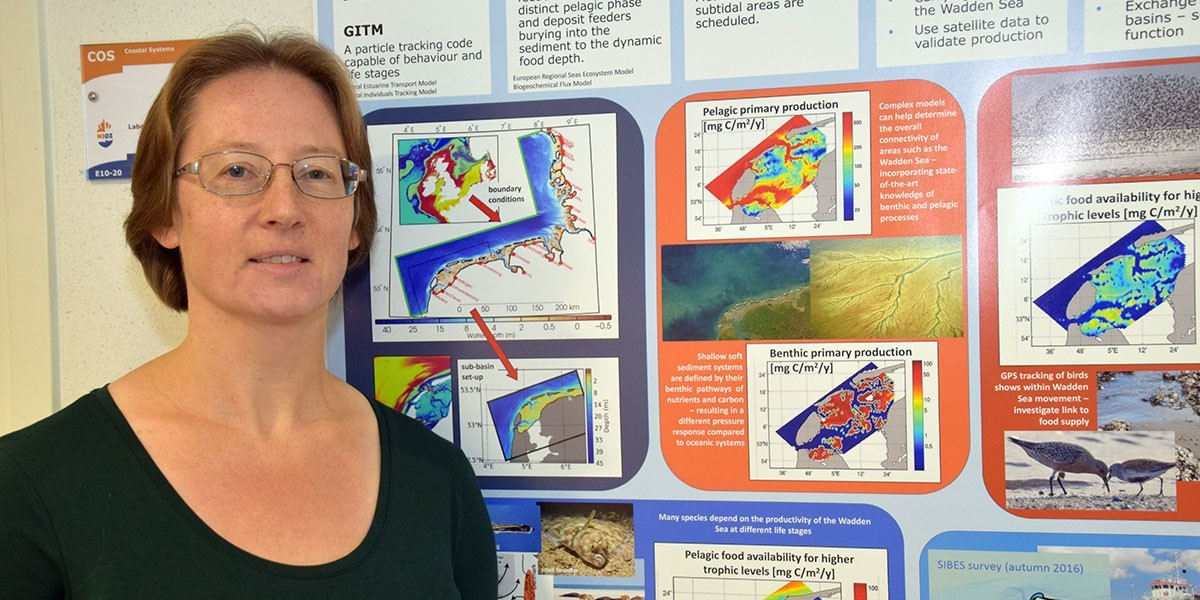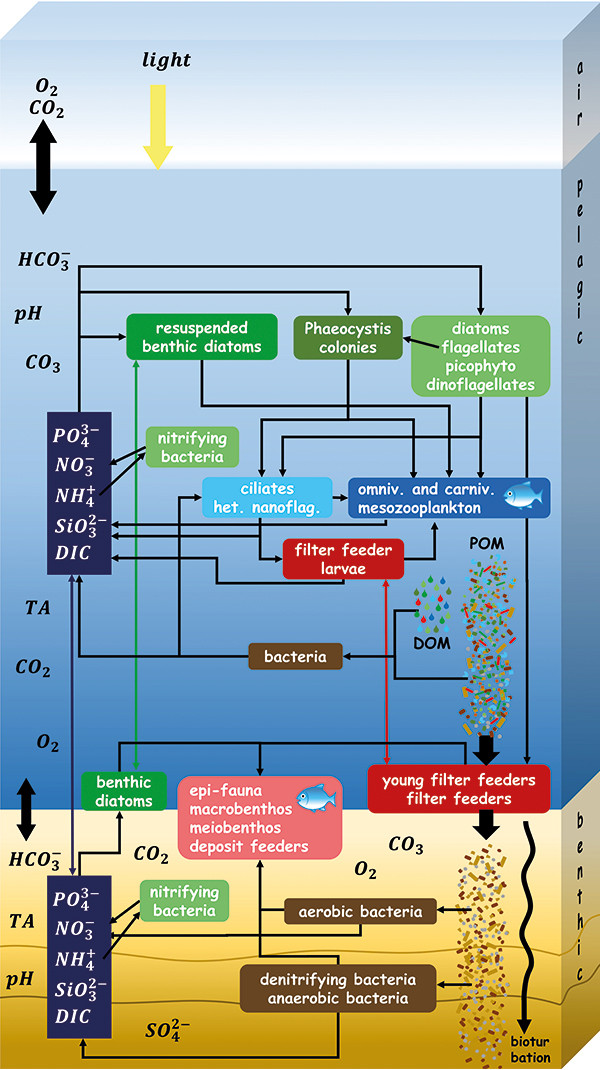End-2-end

Size-based model
Schematic of an end-2-end model consisting of a hydro-biogeochemical model (left) and a (double pathway) size-based model (right). The size-based model discriminates between size-selective feeders (pelagic predators) and non-size selective feeders (detritivores). Here, two-linking is visualized where both models impact upon another, though one-way linking upwards (with plankton and detritus input to the higher trophic level model but no predation feedback) is more common and has been applied in (van Leeuwen, 2016). Note that the size-based model does not represent individual species, but uses weight classes, with small adult fish and young large fish sharing the same weight class.
Holistic view
End-2-end modelling couples different models, which each describe a part of an ecosystem, together in an attempt to describe the whole ecosystem in one go, from its physics and chemistry through to small organisms, larger ones and sometimes also the economic use that mankind relies on from that system. This holistic view is necessary in what has been called the 'ecosystem approach', that is the consideration of the system as a whole and not individual parts, as its stressors will be felt throughout the system and not just in the part that is most directly affected. For instance, climatic changes will affect commercial species directly (higher sea water temperatures may impact on spawning success, or suitable habitat range), but will also indirectly affect them through food web changes (increased primary production may favour seabed creatures or bacteria, reducing prey species).
On the other hand fishing effort (usually targeted at larger species) will directly affect grazing pressure on smaller species, which will, in due turn, affect plankton levels. Thus, a model that describes the whole system is needed in order to study the combined effect of top-down (directly impacting on the top of the food web, i.e. the top predators) and bottom-up (directly impacting on the bottom of the food web, i.e. the primary producers) pressures. Top-down stressors are usually fishing pressure, while bottom-up stressors include climate change, ocean acidification and eutrophication (excess nutrients input).
The models GETM & ERSEM-BFM
Here at the NIOZ we use the hydrodynamical model GETM coupled to the biogeochemical model ERSEM-BFM. This combined model describes the physics, chemistry (nutrients), geology (sediment type) and biology up to plankton level (the organisms that cannot control their horizontal movement, but are transported by the water motions). GETM-ERSEM-BFM is then coupled to a size-based model with 2 size-based pathways: pelagic predators, which feed in a size-selective manner, and detritivores, which share a common pool of detritus. Thus, an input of plankton will cause a slow transfer of energy up the pelagic predators pathway (as one size-class eats another), while an input of detritus will immediately give an energy boost to all detritivores irrespective of size. As pelagic predators also eat the detritivores in this model the main dynamics of the marine system are included, without individual species representation. As fishing pressure is also size-selective (net mesh size), this end-2-end model is capable of giving a first indication of impacts on higher trophic levels for combined stressors (van Leeuwen et al, 2016) and can be used for management studies.
New publication
Marine Ecology Progress Series (MEPS)
Climate change, marine resources and a small Chilean community: making the connections
Contact
For information on the End-2-end model, please contact Sonja van Leeuwen by email (preferred). You wil get a response as soon as possible. In urgent matter, you can contact her directly.
T +31 (0)222 369 423
Information
End-2-end modelling couples different models

ERSEM-BMF model

Schematic representation of nutrient and carbon flows in the biogeochemical model ERSEM-BFM, including DOM (Dissolved Organic Matter), POM (Particulate Organic Matter) and DIC (Dissolved Inorganic Carbon). TA stands for Total Alkalinity. The fish symbol indicates mortality due to fish predation, which is included in the model as cannibalism to ensure a biomass-based response (more prey biomass means increased predation). The sea bed consists of 3 layers: the oxic layer, the denitrification layer and the anoxic layer, which are separated by the oxygen penetration depth and the sulfide horizon depth, respectively.